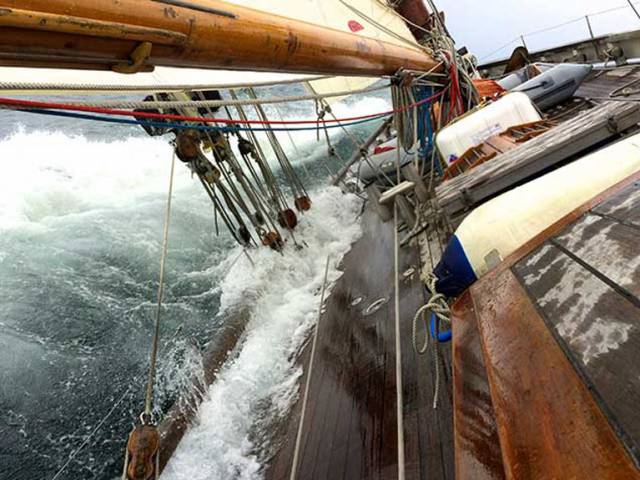When the Irish Cruising Club was established in Glengarriff at the head of Bantry Bay on Saturday 13th July 1929, the friendly gathering of the crews from a modest flotilla of five decidedly varied sailing yachts – mostly small craft by today’s standards - had several clearly defined purposes in mind writes W M Nixon.
Certainly, they wanted to engender greater interaction and cohesion among Irish cruising enthusiasts - and greater respect too, as the high-profile racing community tended to look down on them with some disdain, for they saw cruising people as being no more than ordinary sailing folk who simply didn’t race. So in order to give more credence to the organised aspects of their life afloat, they planned to produce an Annual filled with logs of the cruises they’d achieved each year in order to give a more complete picture of the new ICC’s activity.
But for many members, the new club’s most important objective was to be the researching and publication of detailed sailing directions and harbour guides for Ireland’s most popular cruising coasts. Until then, information about the more remote parts could only be found in Admiralty Pilot Books which were aimed at ships rather than smaller craft, or else it was in the realms of that precious commodity “local knowledge”, often jealously guarded by those who had it. In the growing mood of amateur enthusiasm for cruising, self-reliance was a central factor, and that was dependent on having ready access to inside information.
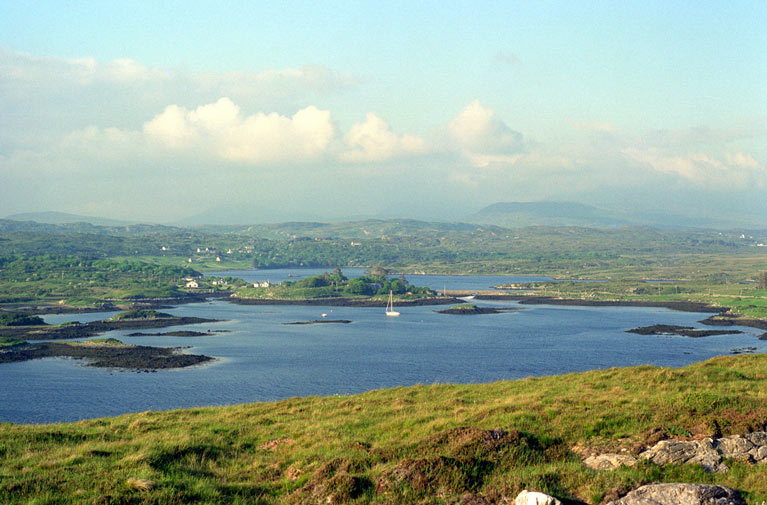 Local knowledge at its best. Thanks to the ICC Sailing Directions, anyone cruising Ireland’s Atlantic seaboard will know there’s this perfectly-sheltered anchorage hidden at Ardbear at the head of Clifden Bay. Photo: W M Nixon
Local knowledge at its best. Thanks to the ICC Sailing Directions, anyone cruising Ireland’s Atlantic seaboard will know there’s this perfectly-sheltered anchorage hidden at Ardbear at the head of Clifden Bay. Photo: W M Nixon
Founding member Harry Donegan of Cork, who more accurately could be described as the leading ICC inspirer, had been one of the seven entrants in the inaugural Fastnet Race of 1925 with his 15-ton cutter when he’d finished third overall. But as a sailing polymath with much cruising experience, he’d been creating Sailing Directions for southwest Ireland since 1912, when he had also first aired the idea of an Irish Cruising Club. However, the outbreak of the Great War in 1914 put that notion on hold until 1922 when he was developing the idea further with his fellow cruising friend Billy Mooney of Howth. But the War of Independence followed by Partition and the Civil War had created little space for such ideals, so it was 1929 by the time the club finally came into being.
Yet through all the delays, the aspiration for the production of reliable cruising guides to Ireland by voluntary effort for general publication remained high on the list of priorities, and today with the entire coast covered in two comprehensive volumes edited by Norman Kean of Courtmacsherry with his wife Geraldine Hennigan providing invaluable backroom support, the two books have gone through more than a dozen editions, and they continue to give great service for visitors and locals alike.
Indeed, such a steady role is played by these Directions that there’s a danger we take them for granted, so it needs an outside view to puts their importance in perspective. We’ve received that twice already this year in the accounts, by leading Inland Waterways enthusiasts Paul Scannell and Mary Healy of Galway, of their first venture round Ireland last year in the 1977-vintage Broom Ocean 37 motor-cruiser Arthur - normally a boat associated with the Shannon, but one which is capable of a round Ireland cruise if you’re careful with reading the weather.
They told of their experiences at the Irish Sailing Cruising Conference at Lough Ree YC in February, making the point that having the ICC Directions is essential. And then in the recently-published Spring 2019 edition of the IWAI’s Inland Waterways News, with Paul’s fascinating account of their very thorough preparation, planning and execution of this voyage, there are again several references to the indispensable assistance they found in the ICC Directions.
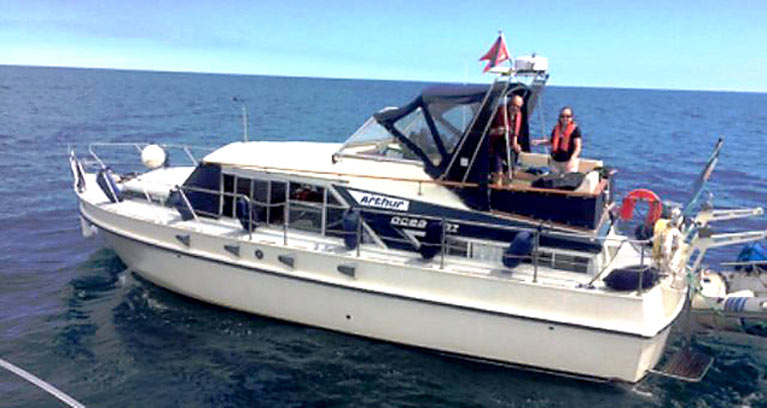 ICC beneficiaries – inland waterways cruisers Paul Scannell and Mary Healy with their vintage 37-footer Arthur found the ICC Sailing Directions to be “indispensable” during their round Ireland cruise last summer.
ICC beneficiaries – inland waterways cruisers Paul Scannell and Mary Healy with their vintage 37-footer Arthur found the ICC Sailing Directions to be “indispensable” during their round Ireland cruise last summer.
That of course was the intention of those founding fathers 90 years ago in 1929. But in an era when the ICC has acquired a considerable extra glamour with the recent organisation by western member Peter Haden (he’s from Ballyvaughan in County Clare) of an extremely well-supported Cruise-in-Company in northwest Spain, it is timely to be reminded that the very useful work put in train by the club from the start is still being maintained. So much so, in fact, that as Norman Kean and Geraldine Hennigan were with the fleet in Galicia with their Warrior 40 Coire Uisge, while they were out there they did a spot of local surveying in order to provide better information about some previously under-utilised channels.
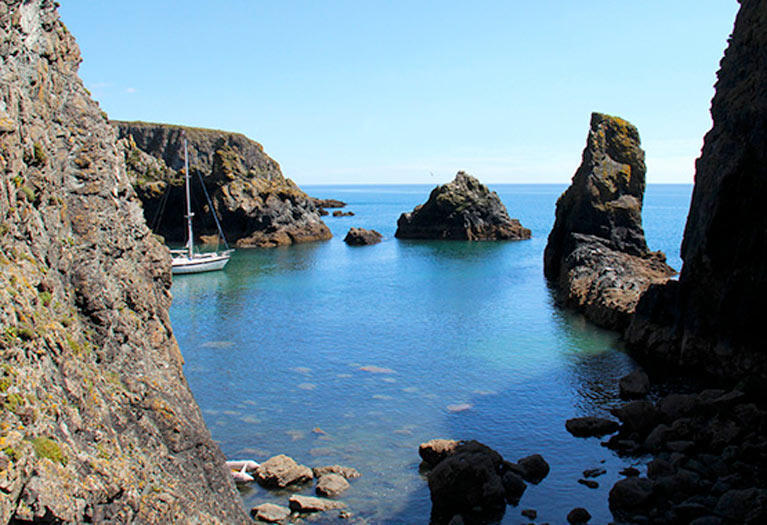 Norman Kean and Geraldine Hennigan’s 40-footer Coire Uisge on a detailed pilotage study of Waterford’s Copper Coast. When in northwest Spain during the ICC’s recent Cruise-in-Company, they found themselves surveying local under-utilised channels for the benefit of fellow-cruisers. Photo: Norman Kean
Norman Kean and Geraldine Hennigan’s 40-footer Coire Uisge on a detailed pilotage study of Waterford’s Copper Coast. When in northwest Spain during the ICC’s recent Cruise-in-Company, they found themselves surveying local under-utilised channels for the benefit of fellow-cruisers. Photo: Norman Kean
In an era of centralisation and the seemingly inevitable spread of professional administration, the ICC is the very model of a de-centralised, all-Ireland organization based on voluntary effort. The office of Commodore rotates around the four regions, and is currently held by Stanton Adair of Belfast Lough, but both the Honorary Secretary Alan Markey and the Vice Commodore Tom Fitzpatrick are based in Howth, while other flag offices and committee places are spread throughout the four provinces in a way which partially reflects the membership distribution, yet also encourages the growth of membership numbers where previously they’d been sparse.
But it is the specialist positions which are the engines of the club, and best reflect its countrywide nature. The all-important Annual is currently edited by Maire Breathnach of Dungarvan, and she has raised it to a quality which comfortably rivals many professional publications, despite being for a membership of just 550.
As for communication with members, the ICC Web Editor is John Clementson who lives on the shores of Strangford Lough, but the editorship of the cherished quarterly newsletter – again of magazine standard – is done by Alex Blackwell, who is likewise a shoreside dweller, but this time on the Atlantic seaboard at Clew Bay in Mayo.
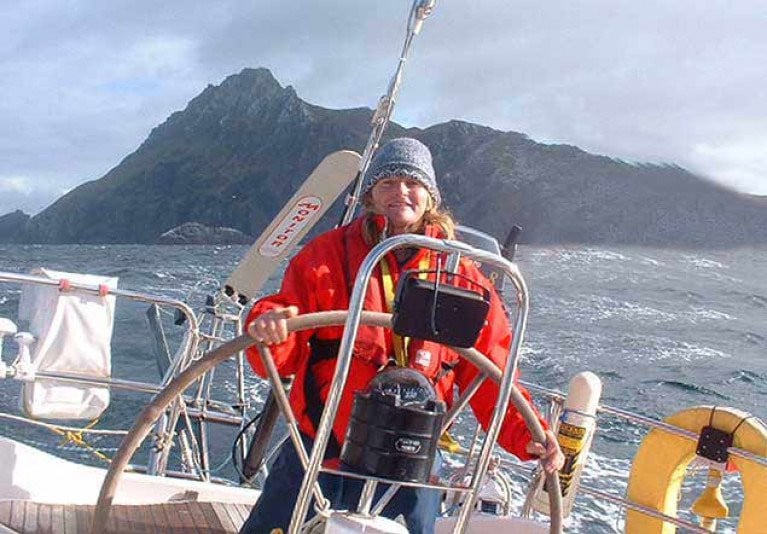 Editor at large…..Maire Breathnach at the helm off Cape Horn
Editor at large…..Maire Breathnach at the helm off Cape Horn
All these tasks successfully maintain communication among a membership who still tend mostly to do their cruising in summertime in the northern hemisphere, but there are always some others somewhere on longer voyages. In other words, most of the activity of ICC members would be invisible were it not for the fact that they’re highlighted with the annual awards, presented each year at the AGM, which is the only event where ICC members are obliged to be in Dublin.
While fellowship, conviviality and a shared love of boats and sailing across oceans, or along coastlines familiar or new, is enough to bind the club in remarkable ties of friendship, there is one occasion every year when they get together simply to have a party, meet new members, and welcome flag officers from the international matrix of cruising clubs.
That occasion is the Annual Dinner, whose organisation rotates round the ICC’s four regions, and for 2019 it fell to the Southern Committee and Rear Commodore Lonan Lardner of Waterford to take on the mantle. It’s quite a challenge, but the cruising folk of the south have the advantage of having Killarney in their region, and there’s little that the smooth-running hospitality industry of Killarney didn’t know last weekend about looking after a dinner for 247 people.
In the midst of an active weekend of multi-activities which saw some ICC members disappear up mountains (don’t worry, they came back down again), others went on historical tours. As for our little group of special friends – with more years of combined membership between us than we care to count – we went off on a tour of the Ring of Kerry – mercifully uncrowded for it was the weekend after St Patrick’s Day – and took in harbours and happy watering holes, and saw the incomparable Derrynane at its pristine best (not one boat of any kind in the anchorage, first time I’ve ever seen it like that), and then relaxed in the history-laden comfort of Parknasilla.
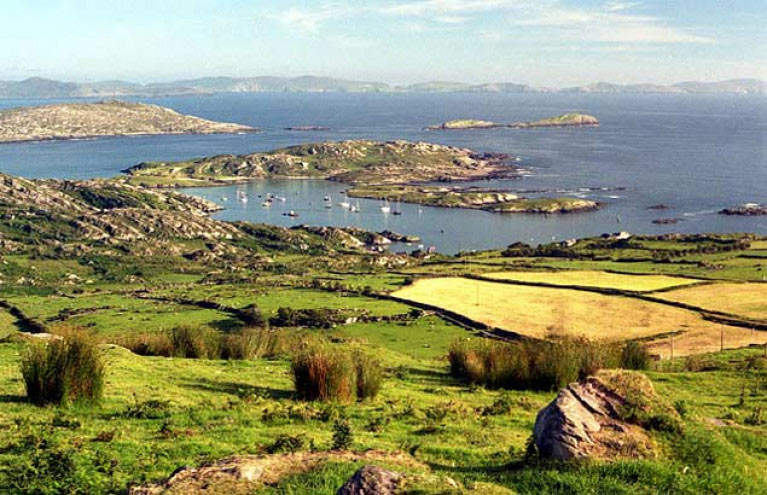 Derrynane in high summer. This tiny anchorage in West Kerry is unrivalled for its links with notable sailors, as those connected with it include Daniel O’Connell, Lord Dunraven of America’s Cup fame, pioneering world circumnavigator Conor O’Brien, and current Irish international offshore superstar Damian Foxall.
Derrynane in high summer. This tiny anchorage in West Kerry is unrivalled for its links with notable sailors, as those connected with it include Daniel O’Connell, Lord Dunraven of America’s Cup fame, pioneering world circumnavigator Conor O’Brien, and current Irish international offshore superstar Damian Foxall.
That set us up nicely for the scenic route back to Killarney from Sneem up to Moll’s Gap, and then it was into the scrum of the dinner. With 247 present and on top form, you’re going to meet and greet an impressive number of folk, but – when anything resembling conversation is possible - is never quite going to take the course expected.
Thus I found myself sharing an enthusiasm for rudders which fit neatly under the hull for maximum endplate effect with the charming Brad Willaur, Commodore of the Cruising Club of America, a line of thought inspired by my very high regard for the classic Jim McCurdy-designed 48-footer Carina aboard which Brad has raced with current successful owner Rives Potts.
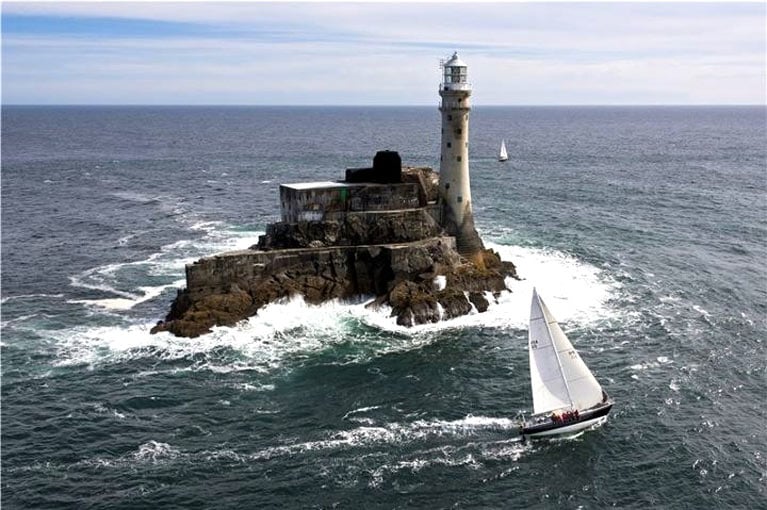 Carina rounds the Fastnet in the race of 2011, when she won her class. It’s indicative of the changeable nature of Ireland’s weather that this photo was taken just nine hours after Rambler 100 had lost her keel in much more rugged conditions in the same location. Photo Rolex/Daniel Forster
Carina rounds the Fastnet in the race of 2011, when she won her class. It’s indicative of the changeable nature of Ireland’s weather that this photo was taken just nine hours after Rambler 100 had lost her keel in much more rugged conditions in the same location. Photo Rolex/Daniel Forster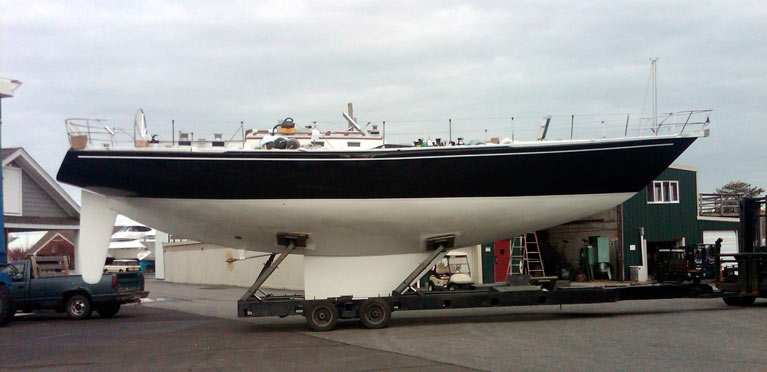 Still looking good after 50 years – the 48ft Carina’s hull may look completely different from today’s offshore racers, but she’s still very much in the frame, and can even provide her crew with some on-board comfort whole continuing to win races. Photo: Rives Potts
Still looking good after 50 years – the 48ft Carina’s hull may look completely different from today’s offshore racers, but she’s still very much in the frame, and can even provide her crew with some on-board comfort whole continuing to win races. Photo: Rives Potts
When Carina first came to Ireland brand new in 1969, she was in the Transatlantic Race to Cork as part of the buildup to the Royal Cork’s Quarter Millennium, and she then went on to do the Fastnet of that year. The word is that she’s coming back for this year’s Fastnet as part of her Golden Jubilee celebrations, but meanwhile I recalled that one of her crew for that 1969 Transatlantic passage was a very youthful Ron Cudmore, and sure enough there was Ron in Killarney, like us all not quite as young as he used to be, yet still very definitely Ron Cudmore.
But in terms of age defiance the total star of the show was his brother, sailing superstar Harold Cudmore, who was there to mark an extraordinary number of years as an ICC member, for in the days of his youth the ICC had a strong Crosshaven and family bias, and Harold got in as a mere lad. But nevertheless, he has defied the years so well that he looks about ten years younger than the number of years he has been in the club.
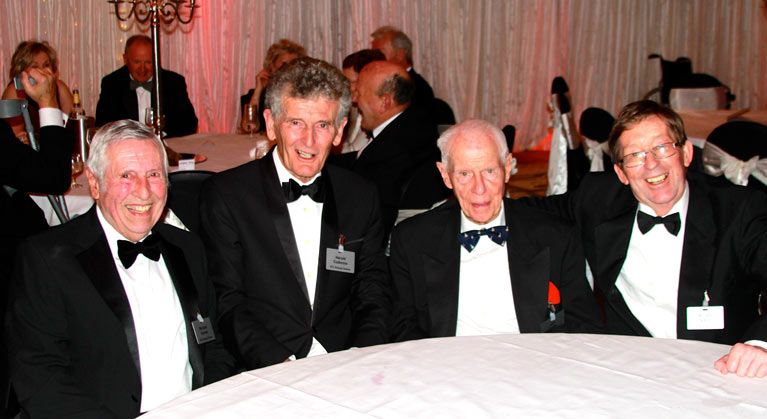 Kerrymen for the day. This quartet in Killarney last weekend could muster 229 years of ICC membership between them. They are (left to right) Dickie Gomes, Harold Cudmore, Jack Wolfe and Winkie Nixon. Photo: Alex Blackwell
Kerrymen for the day. This quartet in Killarney last weekend could muster 229 years of ICC membership between them. They are (left to right) Dickie Gomes, Harold Cudmore, Jack Wolfe and Winkie Nixon. Photo: Alex Blackwell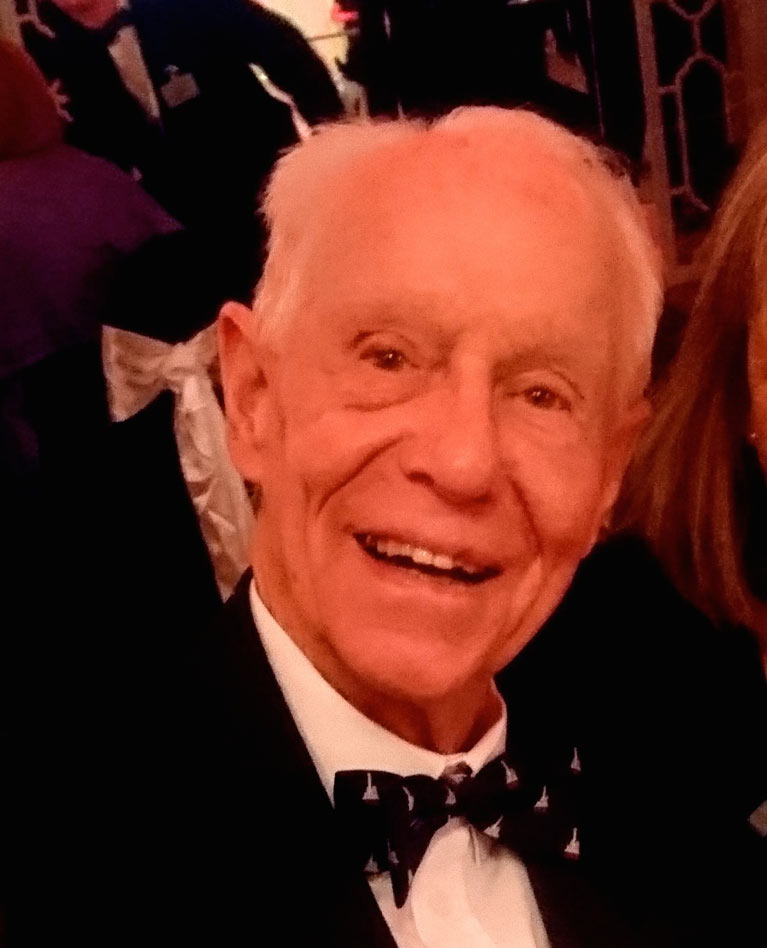 Senior of the seniors – at 95, Jack Wolfe is the ICC’s most senior member, and is probably the only person today who was with Conor O’Brien on the Saoirse in the 1930s. Photo: Rose Michael
Senior of the seniors – at 95, Jack Wolfe is the ICC’s most senior member, and is probably the only person today who was with Conor O’Brien on the Saoirse in the 1930s. Photo: Rose Michael
He was celebrating with Jack Wolfe, who at 95 is the ICC’s senior member, with a unique direct link of having been aboard Saoirse with Conor O’Brien in 1938. That saw the conversation swing into the unlikely associations which the ICC membership brings up. Who would have thought, for instance, that rugged Arctic voyager and Irish traditional boat enthusiast Paddy Barry would have started sailing with fellow UCD engineering student and subsequent International Dragon and superyacht owner Mick Cotter?
Yet they did that by buying an oldish 505 dinghy and using it for camping cruising, one of their more noted ventures being a fast unaccompanied sail from Roundstone in Connemara out to Kilronan in the Aran Islands. On this being mentioned to Harold, he immediately recalled that the boat in question had originally been Joe Woodward’s Dotie Pet, one of the most successful of the Crosshaven fleet of 505s, and then almost exactly on cue, Joe Woodward himself emerged from the ICC Killarney melee with a request.
For a long time now, he has been a summer fixture of the Galician coast with his Salar 40 Moshulu III. But when he was clearing out the boat last season, he found a rather special Irish ensign. It seems that when Moshulu first arrived in northwest Spain many years ago, his first anchorage to get his breath before entering port was the Iles des Cies off Vigo. Having crossed Biscay, suddenly his little Irish ensign seemed totally inadequate. But it so happened that our beloved Sail Training Brigantine Asgard II was anchored nearby. So Joe hopped in his dinghy and went over and asked if by any chance they had a spare ensign of decent size. They had and more, and they lent him one. So though Asgard II may now be gone, Joe Woodward of Cork has one of her ensigns, and he’d very much like to see it being used for some useful and preferably charitable purpose.
In a hectic weekend like this, there’s bound to be the occasional hiccup, and I managed a beauty by crashing a flying boat. We were travelling down to Killarney in convoy with the legendary Dickie Gomes, voyager extraordinaire, and when a boring rainbelt moved in, my mother-in-law’s daughter cleverly suggested we let it pass through by visiting the Flying Boat Museum at Foynes. She knew that Dickie’s father used to be General Manager of Short Brothers & Harland in Belfast where they’d built the famous Sunderland Flying Boats after the company had been moved lock, stock and barrel from Kent from 1938 onwards in order to locate it further away from the Hitler unpleasantness.
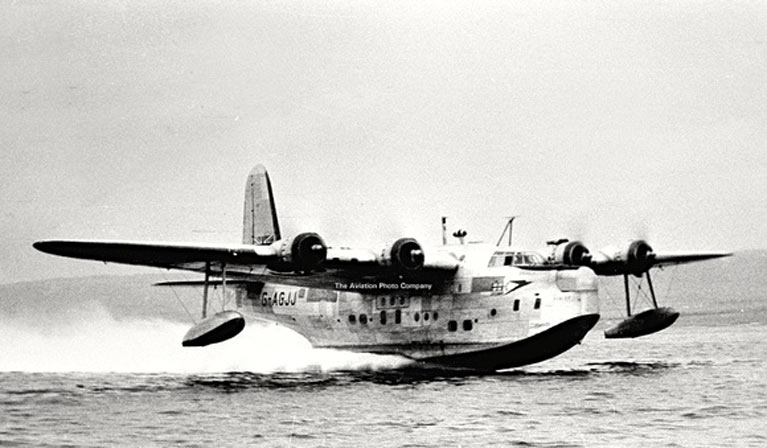 Cruising boat with a difference – Short Sunderland flying boat getting airborneIt’s a fascinating setup, that Foynes museum, complete with a full-size replica Boeing B314 flying boat, aka the Pan Am Clipper, but there are also flight simulators in which you could be in any type, and we decided we were on which Dickie had flown from Belfast Lough.
Cruising boat with a difference – Short Sunderland flying boat getting airborneIt’s a fascinating setup, that Foynes museum, complete with a full-size replica Boeing B314 flying boat, aka the Pan Am Clipper, but there are also flight simulators in which you could be in any type, and we decided we were on which Dickie had flown from Belfast Lough.
Well, having been an ace Tiger Moth pilot in his youth, he made a lovely job of flying the simulator. But I crashed, and had to admit so in after dinner chat with Henry Clay, the Commodore of the Royal Cruising Club, whose family hails from Kent. He was interested. “Did you know” he asked, “that Short Brothers were also builders of Thames sailing barges?”
Neither of us did. Nobody in Killarney did except Henry. But the sailing barge Lady Daphne was built by Short Brothers of Rochester, Kent in 1923 at a time when demand for flying boats was very limited. The thought that the Short Sunderland Flying Boat is a relative - however remote - of the classic Thames sailing barges is something that takes a bit of getting used to.
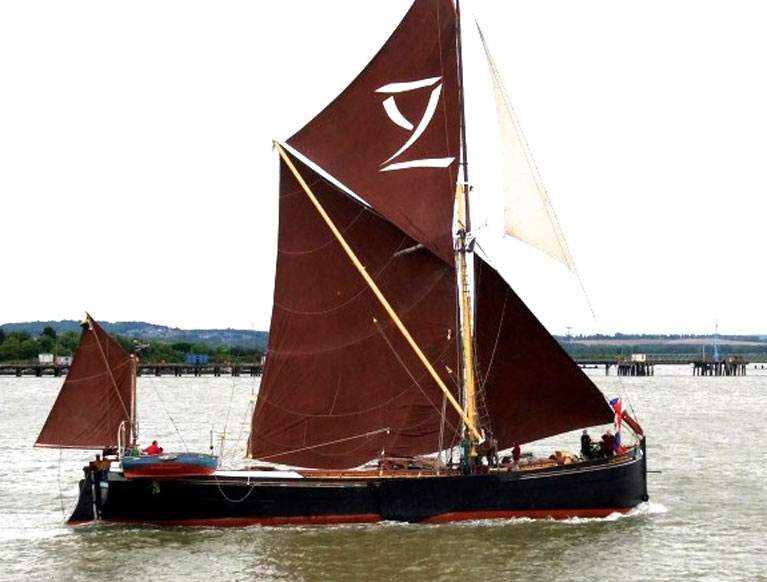 The Thames Sailing Barge Lady Dahne was built in 1923 by Short Brothers at Rochester in Kent. She has been restored and is now a popular entertainment venue in London
The Thames Sailing Barge Lady Dahne was built in 1923 by Short Brothers at Rochester in Kent. She has been restored and is now a popular entertainment venue in London
Yet it was just one of many ideas you have to take aboard in short order at an ICC Dinner. However, an underlying theme is that everyone is thinking of the Tricentenary of the Royal Cork Yacht Club next year. The word is that at least 17 significant American boats are coming across. Heaven only knows how many will join from Europe for the Great Gathering. Most of us still can’t grasp just what 300 years really means. But there’s no doubt many people are determined to get their heads the very idea, for it is going to be something extra special in 2020.
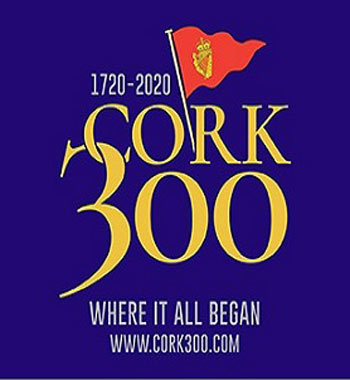 It’s increasingly in everyone’s thoughts, even if many of us still can’t really grasp the full meaning of 300 years of sailing history
It’s increasingly in everyone’s thoughts, even if many of us still can’t really grasp the full meaning of 300 years of sailing history




























